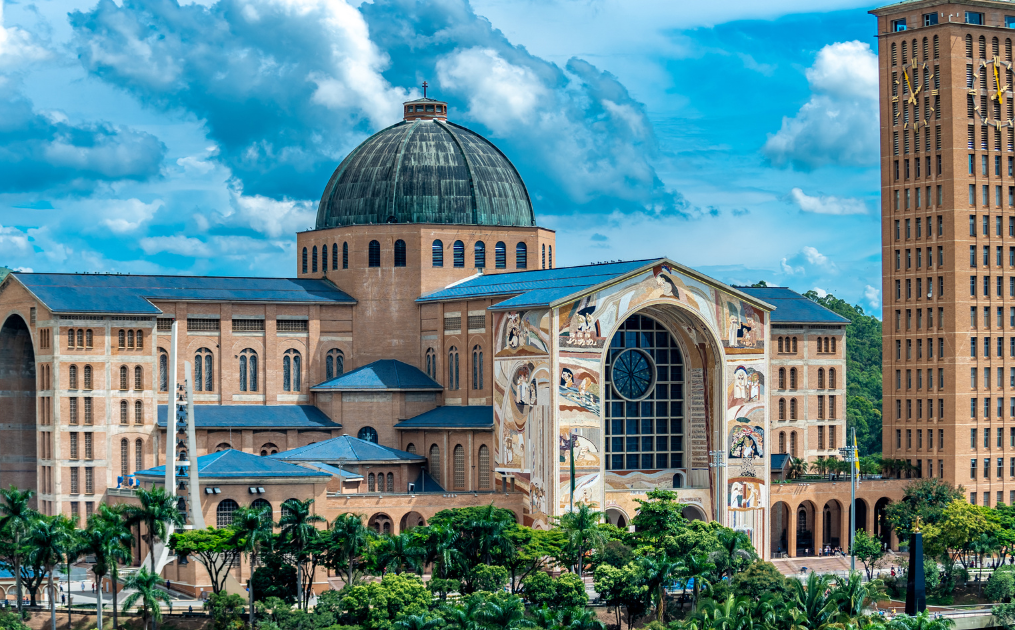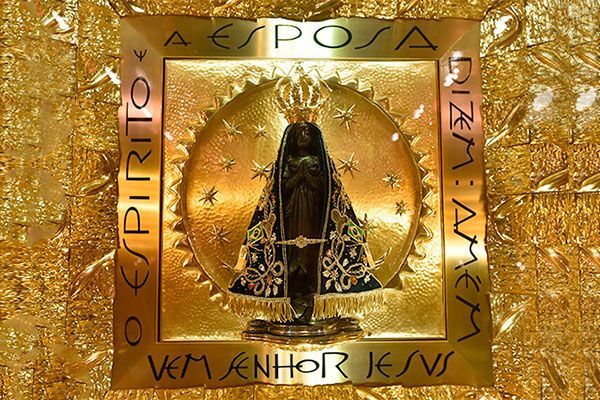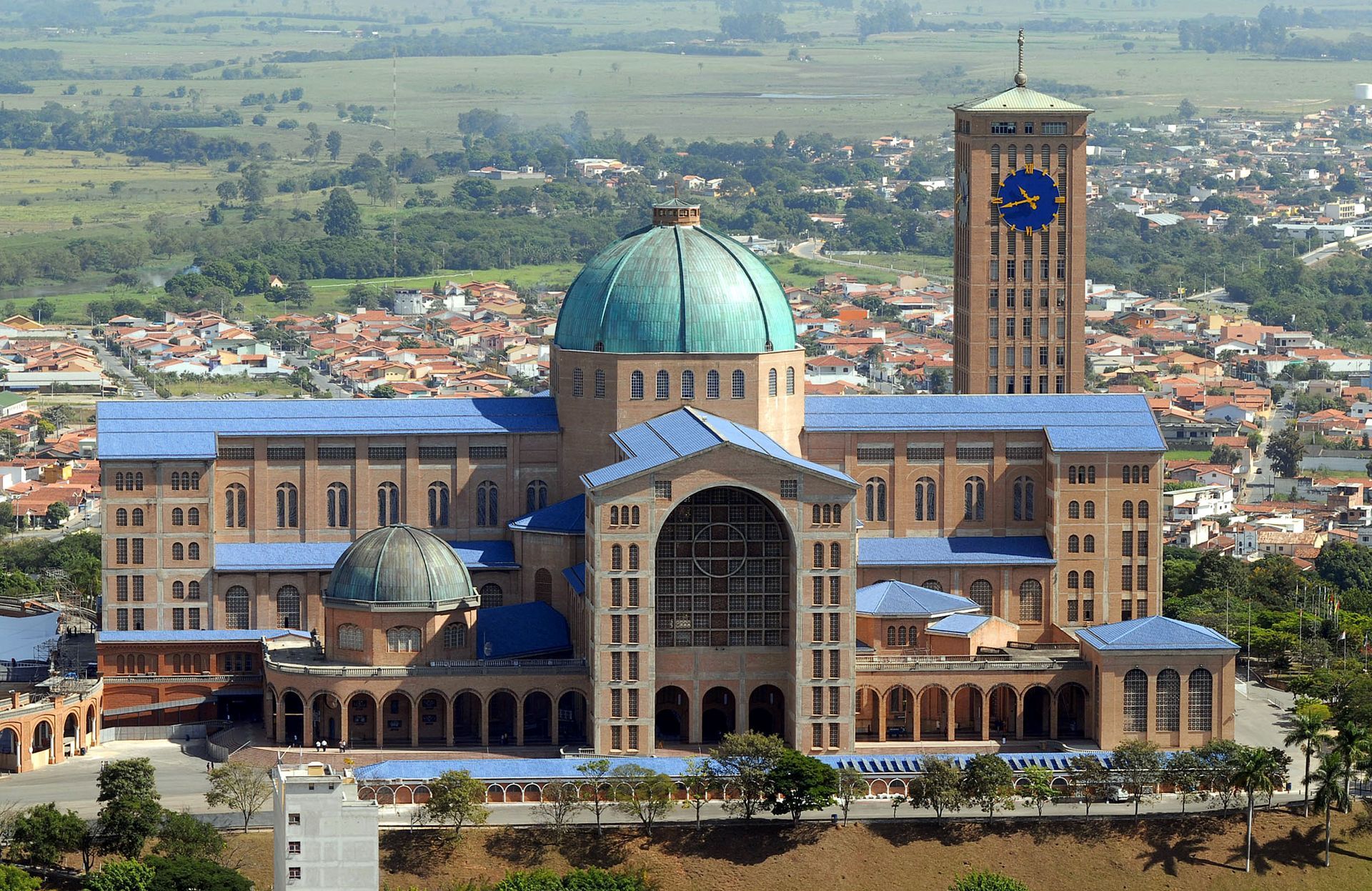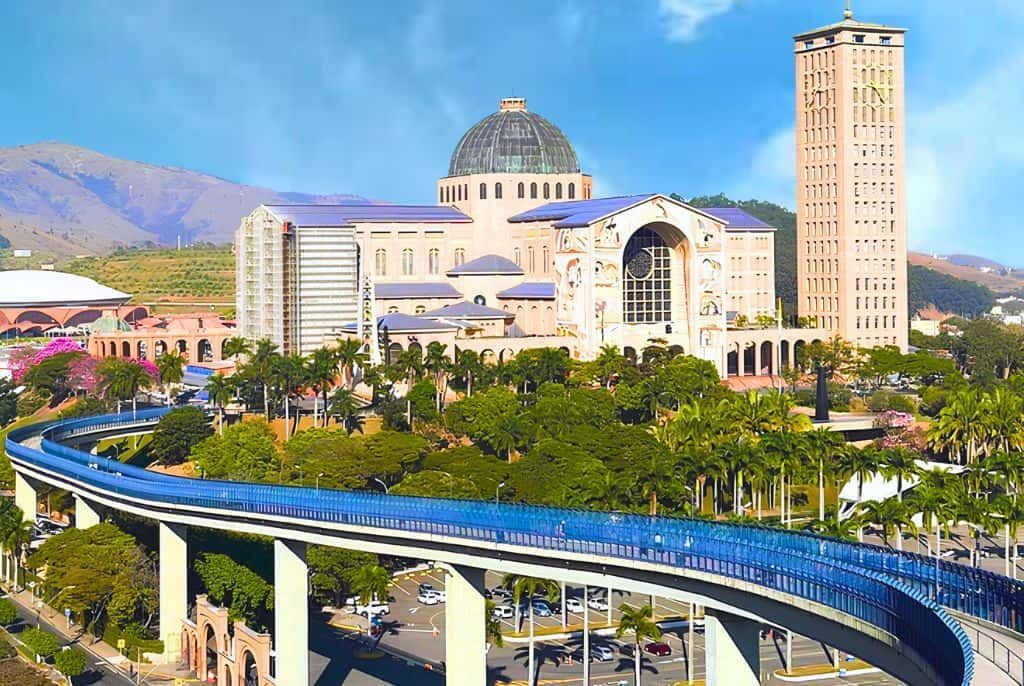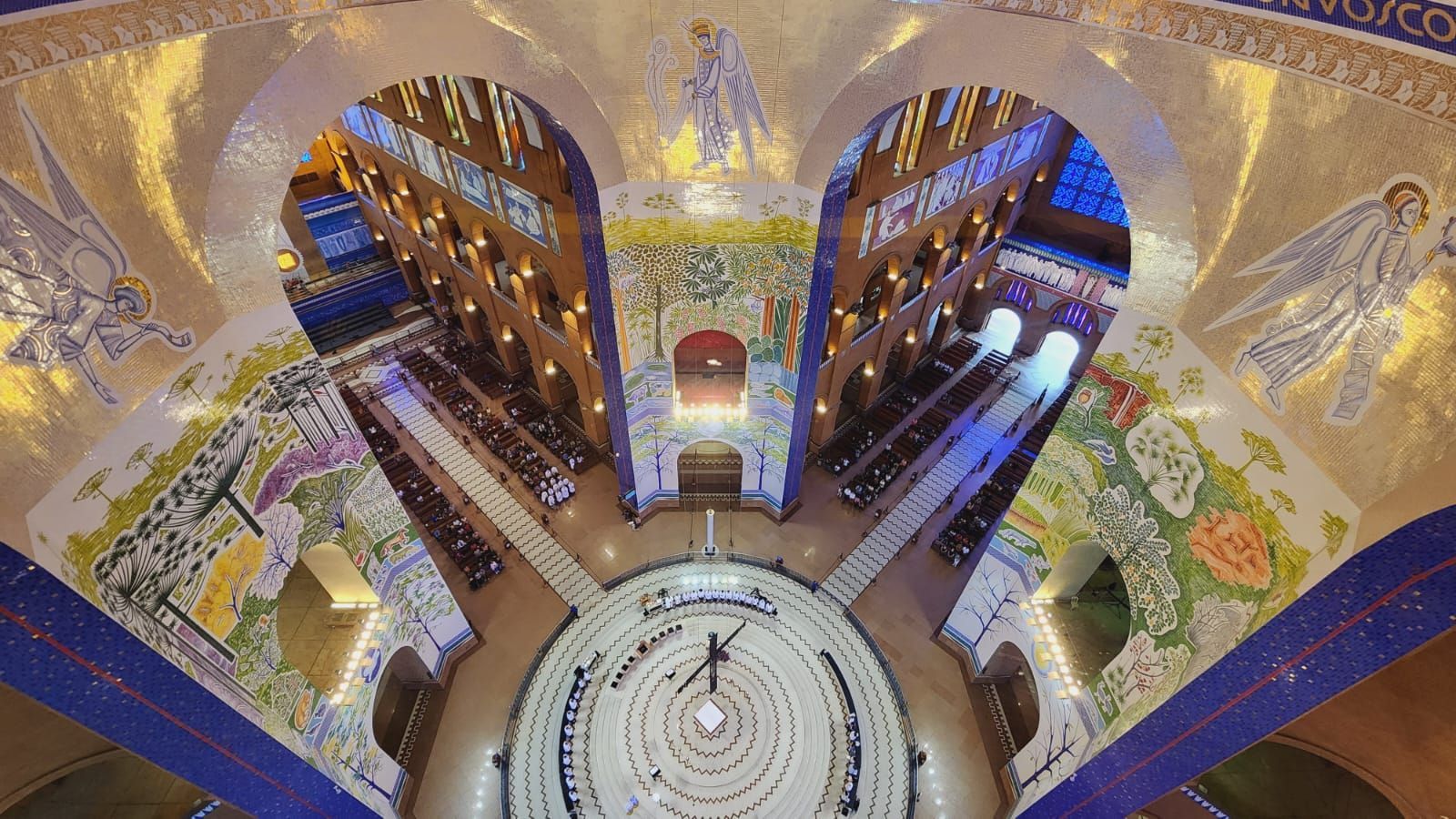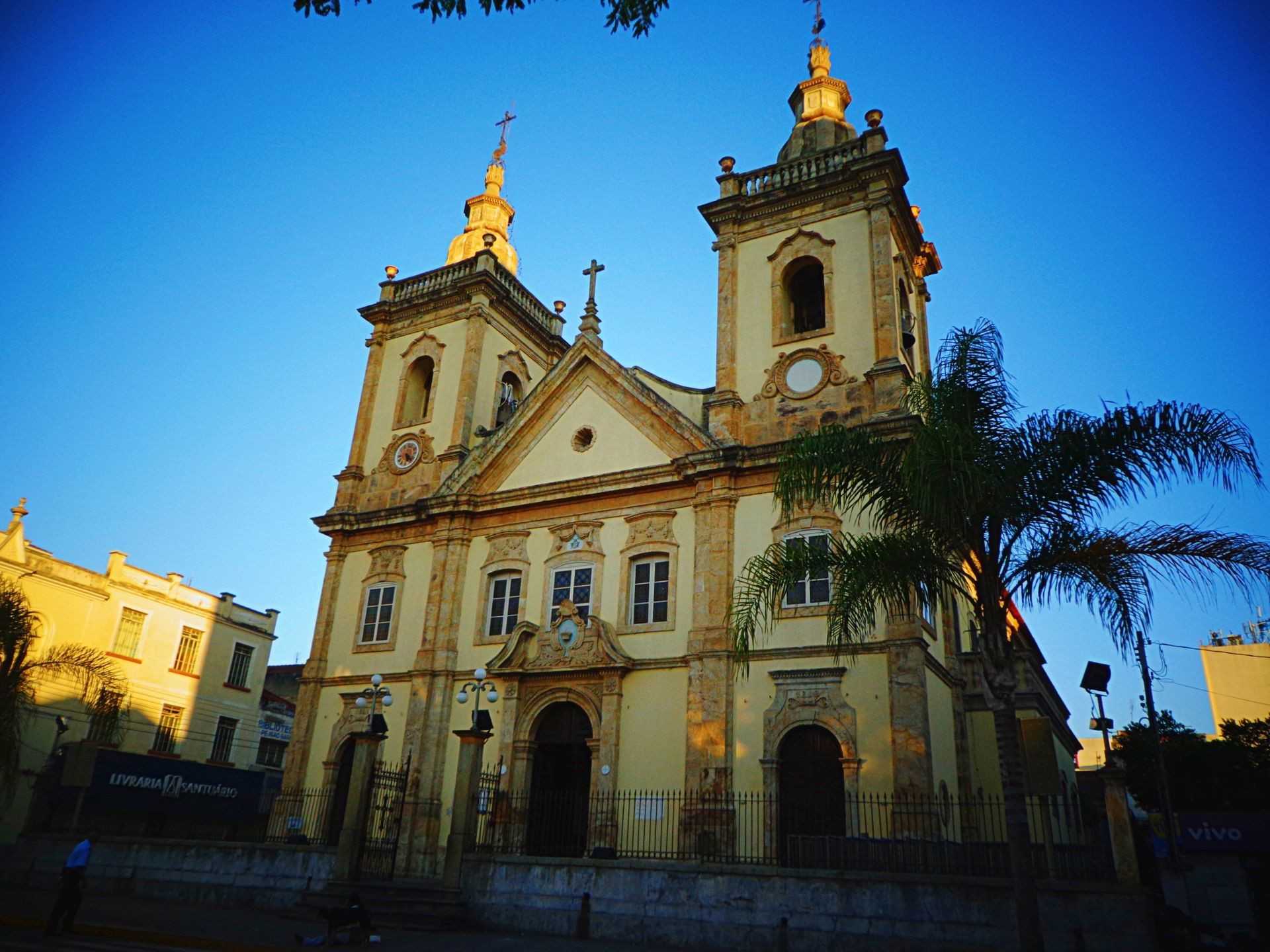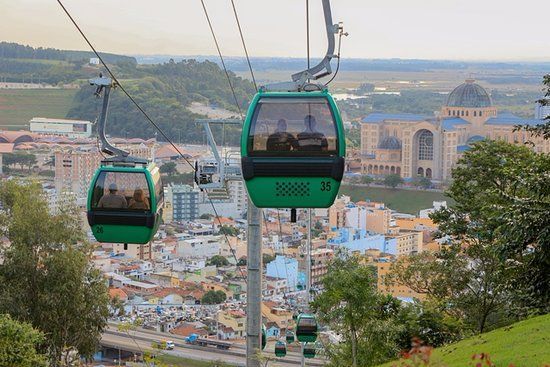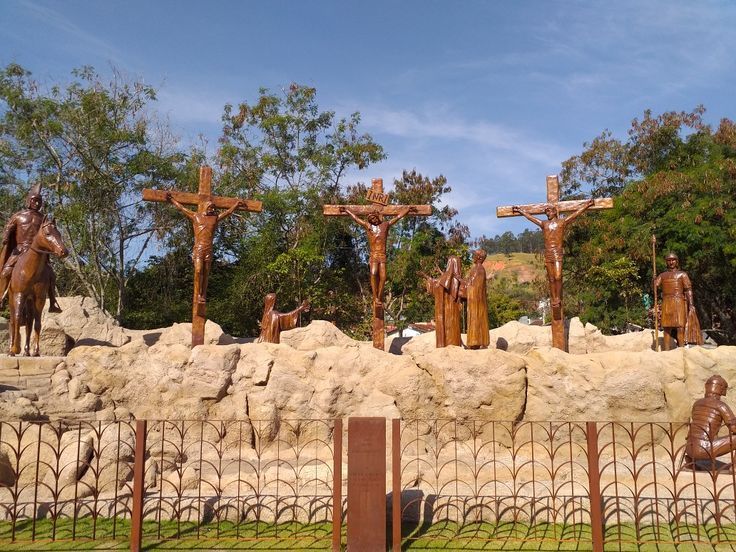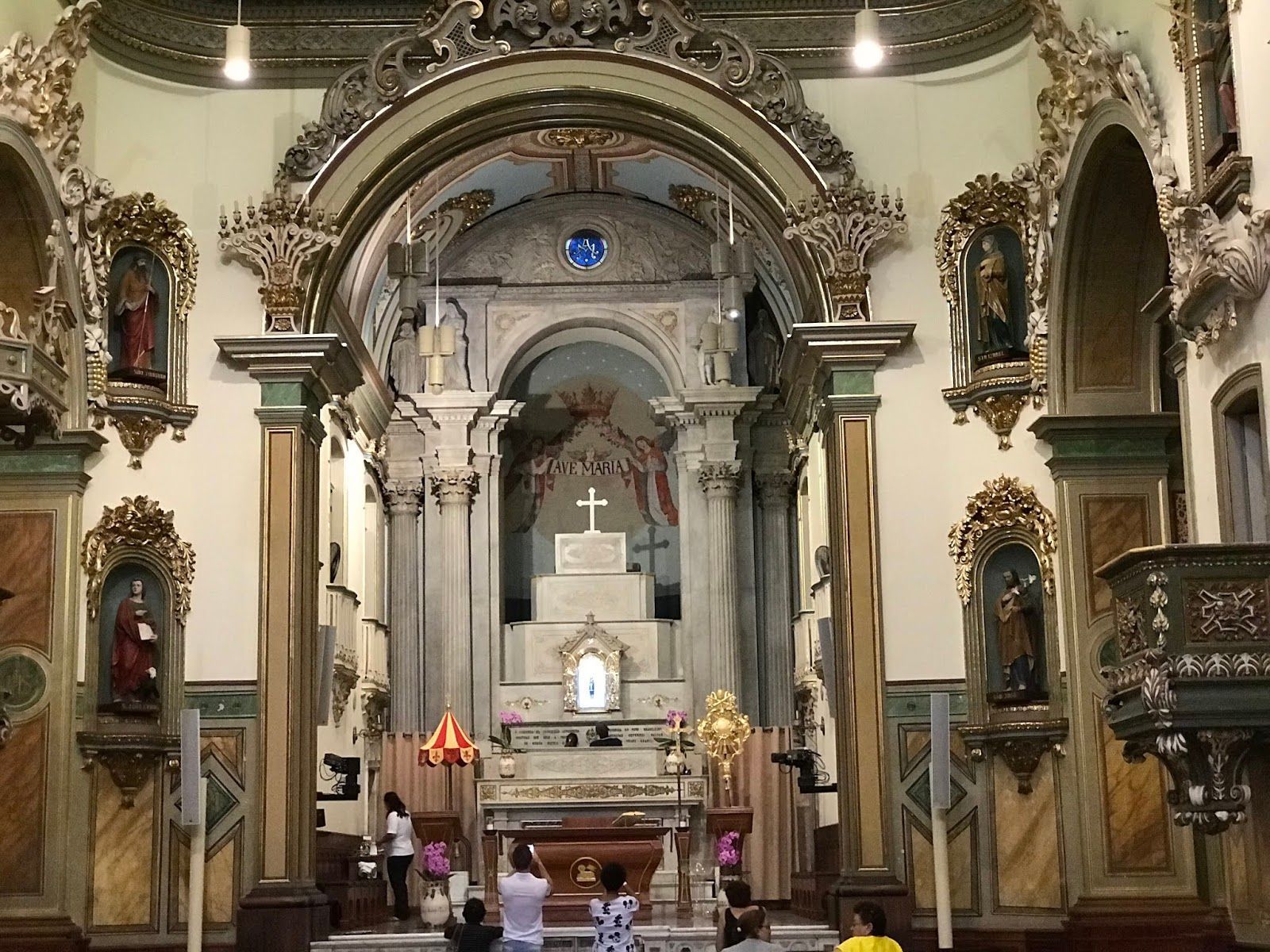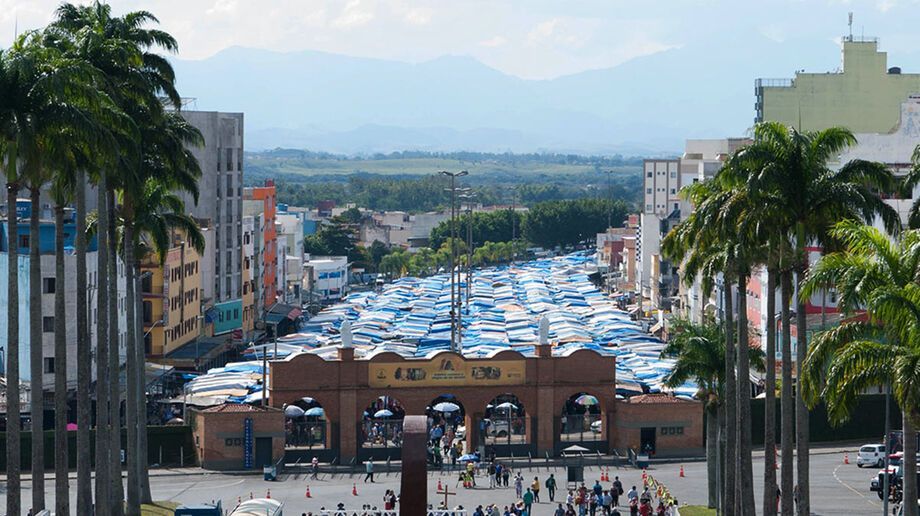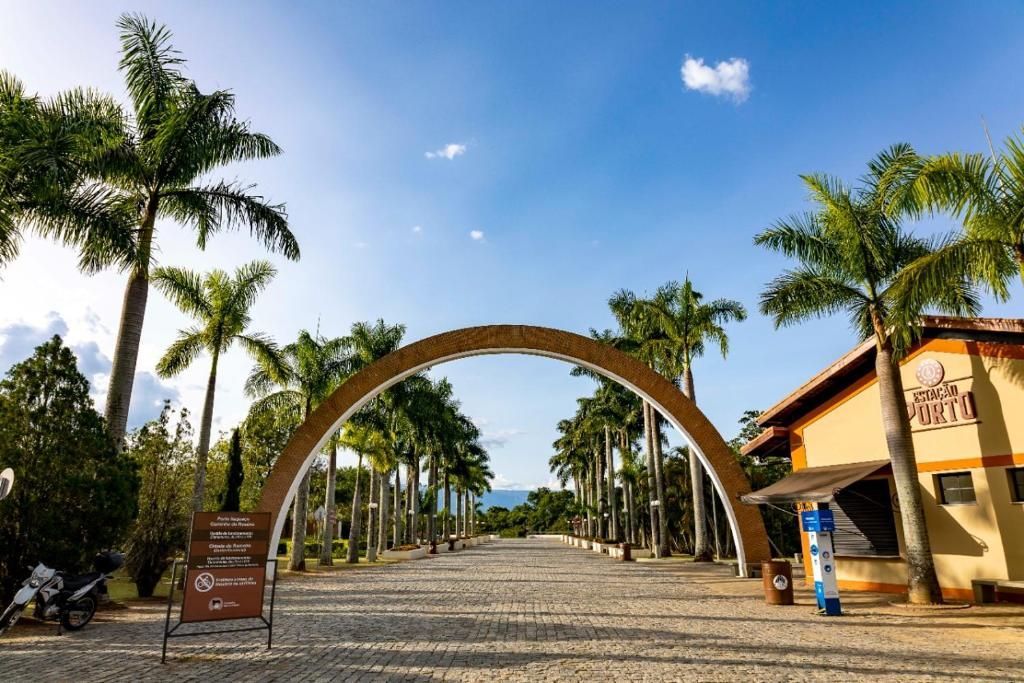Aparecida - SP
On this page, the Portal Peregrino da Esperança presents the city of Aparecida, located in the interior of São Paulo. It is one of the most important centers of faith and pilgrimage in Brazil, recognized nationally and internationally for housing the National Sanctuary of Our Lady of Aparecida, patron saint of Brazil.
🕊️ "May Our Lady of Aparecida illuminate your path
with love, faith and hope.”
Characteristics of the City of Aparecida - SP
The city of Aparecida, located in the interior of the state of São Paulo, is one of the most important centers of faith and pilgrimage in Brazil, recognized nationally and internationally for being home to the National Sanctuary of Our Lady of Aparecida, the patron saint of Brazil. Its history is deeply intertwined with the religiosity of the Brazilian people, beginning in the 18th century, when, in 1717, three fishermen found the image of the Saint in the waters of the Paraíba do Sul River, which, according to tradition, changed the lives of those people and, later, of the entire country forever. From this episode considered miraculous, a process of growing devotion began that quickly went beyond the limits of the region, attracting believers from all over.
The city, which was initially a small village formed around the first chapel built to house the image, developed and transformed over the centuries into a municipality whose identity is directly linked to Marian spirituality and devotion. Aparecida grew in line with the constant increase in the number of pilgrims, becoming a religious hub that boosts not only spiritual life, but also the local economy, which is heavily based on religious tourism. Every year, millions of people visit the city, whether on foot, by bicycle, on horseback or by bus, seeking to give thanks, ask for graces or simply connect with their faith in one of the largest Catholic pilgrimage centers in the world.
The urban development of Aparecida reflects this religious vocation. Its streets, squares, monuments and commercial establishments are deeply focused on serving pilgrims, offering lodging, food, religious products and various services. The presence of the National Sanctuary, one of the largest basilicas in the world, dominates the landscape and stands as a symbol not only of the city, but also of the devotion of an entire country. The Sanctuary, with its architectural grandeur, is not only a temple of prayer, but also a space for meeting, sharing, spirituality and welcome, where all who arrive, regardless of their origin, find an environment of peace and reflection.
Aparecida is, therefore, a city where faith is present in every detail, in every look and in every gesture of those who live there and those who pass by. Its history, built on the simplicity of popular devotion, has become a living testimony of the strength of faith in Brazil. It is a place where the sacred blends with everyday life, where miracles are celebrated, where promises are fulfilled and where hope is renewed every day. More than a religious destination, Aparecida is a symbol of the spiritual identity of millions of Brazilians who find in the small image taken from the waters, and in the city that grew up around it, the deepest expression of their faith, their culture and their hope.
Aparecida represents much more than a geographical point on the map for the thousands of pilgrims who travel the Caminho da Fé. It is the final destination of the Águas da Prata branch, the arrival point of a journey marked by physical overcoming, spiritual introspection and a deep connection with one's own faith. Each step taken, each climb conquered, each obstacle overcome along the way carries as its greatest motivation the desire to arrive before the image of Our Lady of Aparecida, patron saint of Brazil, whose presence symbolizes for many the welcome, protection and fulfillment of promises and thanksgiving.
Arriving in Aparecida after walking the Águas da Prata branch line is not simply completing a physical journey. It is living an experience that transcends the limits of the body and is inscribed in the soul of each pilgrim as a milestone of personal transformation. The difficulties of the route, the landscapes that follow, the cities that welcome you, the encounters with other hikers and the moments of silence and reflection become memories that spiritually enrich those who set out on this journey. When seeing the towers of the National Sanctuary of Our Lady of Aparecida rising on the horizon, the pilgrim experiences an intense mix of emotion, gratitude and reverence, as they understand that this moment represents not only the end of a journey, but also the beginning of a new stage in their own life, marked by the renewal of faith and overcoming their own limits.
The fact that Aparecida is the final point of the Águas da Prata branch carries a profound symbolism, as it summarizes the essence of the Caminho da Fé itself. Just like life, the journey is made up of challenges, choices, ups and downs, moments of solitude and fraternity, always guided by hope and the confidence that there is a greater meaning behind each difficulty faced. Upon arriving at the Sanctuary, the pilgrim kneels, looks at the image of the Saint taken from the waters more than three centuries ago and understands that each pain, each tear, each smile and each step were, in fact, a prayer in motion, a living declaration of love, faith and gratitude.
Aparecida, therefore, is not just a point of arrival. It is a place where pilgrims find fulfillment of their purpose, where spirituality is embodied in the embrace of Mother Aparecida, who welcomes everyone without distinction. The sound of the bells, the voices in prayer, the glow of the lit candles and the emotional gaze of thousands of faithful who circulate through the Sanctuary create a unique atmosphere, which transforms that space into a true refuge of faith, hope and love. For each pilgrim, ending the Path of Faith in Aparecida is confirmation that the journey does not end there, but continues in the heart and in life, strengthened by the certainty that, even in the most difficult moments, one is never alone, because the loving presence of Our Lady accompanies and guides each step of the way.
The story of Our Lady of Aparecida dates back to 1717, in the waters of the Paraíba do Sul River, in a region that today corresponds to the interior of the state of São Paulo, between the cities of Guaratinguetá and Aparecida. At that time, three fishermen, Domingos Garcia, João Alves and Filipe Pedroso, were tasked with catching fish for a banquet that would be offered to authorities visiting the region. After countless failed attempts, without catching anything at all, the men, filled with faith and hope, cast their nets once more. At that moment, surprisingly, instead of fish, they found the body of a small terracotta statue, broken and missing its head. Soon after, when they cast their nets again, they pulled the head that completed the statue from the water.
Immediately after collecting the image, the fishermen experienced what they considered a miracle. Their nets, which had been empty until then, began to fill with an abundance of fish, something they interpreted as a divine sign of Our Lady's intercession. From that moment on, the image began to be venerated by families in the region, especially in the home of Filipe Pedroso, who kept it for many years. Little by little, reports of graces, miracles and cures attributed to the intercession of Our Lady of Aparecida began to spread, causing the number of devotees to grow rapidly, going beyond the limits of the locality. In light of these demonstrations of faith, a rustic chapel of adobe and wattle and daub was built on the banks of the Paraíba do Sul to house the image, which soon became too small for the number of faithful who sought it.
With the increase in pilgrimages, the original chapel became insufficient. Between 1834 and 1842, a small baroque church dedicated to the Immaculate Conception was built, today known as the Historic Basilica. It was here that the first masonry temple was built, with a single nave, a simple façade and a camarinha where the image was placed.
Situated on the left bank of the Paraíba do Sul River, on high ground and surrounded by imperial palm trees, it has withstood floods and time, maintaining its architectural simplicity: a façade with thick walls, a classical pediment and a single wooden door, which opens onto a singularly austere nave interior.
Even before the current National Sanctuary was designed, the Historic Basilica welcomed pilgrims in modest conditions, providing them with a space for silence, prayer and contemplation. Its wooden benches, tiled floor and small dressing room where the image of Our Lady rests bear witness to the concrete experience of the first devotees, who placed their intentions, candles and prayers there. It was in this modest Sanctuary that, in the 19th century, the great pilgrimages were created that would gradually transform Aparecida into one of the largest Marian pilgrimage centers in the world.
Over the years and with the uninterrupted growth of devotion, the Historic Basilica had to undergo several expansions and renovations in order to better serve the thousands of pilgrims who came there. In 1888, the church was elevated to the category of Minor Basilica by Pope Leo XIII, a recognition that reflected not only the local importance of the temple, but also its national relevance as a center of spirituality. It was during this period that the city, previously known as Aparecida do Norte, began to consolidate itself as one of the largest Catholic pilgrimage destinations in the country. The Historic Basilica, with its simple façade, imposing altar and delicate stained glass windows, became a symbol of Brazilian faith, a space full of memories, stories and miracles.
It was in this context of spontaneous growth of popular faith that, at the end of the 19th century, the bishop of São Paulo, Dom Lino Deodato, recognized the urgency of offering devotees a stable and organized religious presence in Aparecida.
In response to this invitation, the Congregation of the Most Holy Redeemer – the Redemptorist Missionaries – arrived in Brazil on October 28, 1894, coming from Bavaria, Germany. Among the first to arrive were Fathers Gebardo Wiggermann and Júlio Maria, accompanied by Brother João Nepomuceno. Settling in with that nascent community, they soon inaugurated a community religious life dedicated to serving pilgrims: they celebrated daily masses, heard confessions, led sermons and organized retreats, ensuring that Marian devotion was mixed with the solid Redemptorist catechesis inspired by Saint Alphonsus Liguori.
Since then, the Redemptorists have been committed not only to the worship of the image and spiritual assistance, but also to the structural development of the Sanctuary. They founded the Sanctuary Publishing House, spread the faith through publications and devotional magazines, and coordinated campaigns for the construction of the larger temple.
Official recognition by the Catholic Church was consolidated over the years, and in 1930 Pope Pius XI proclaimed Our Lady of Aparecida as the Patroness of Brazil, further reinforcing her spiritual and cultural importance to the Brazilian people. Her history is full of symbols that reflect the essence of Brazil: simplicity, faith, diversity and the strength of a people who, even in the face of adversity, find in spirituality a source of comfort, hope and overcoming. Thus, devotion to Our Lady of Aparecida transcends generations and borders, remaining alive in the hearts of millions of faithful who seek her protection, believing that, just as in the miracle of the fish, she continues to intercede and illuminate the paths of those who trust in her.
The construction of the current National Shrine of Our Lady of Aparecida is directly linked to the exponential growth of Marian devotion in Brazil, which, over the centuries, transformed Aparecida into one of the largest pilgrimage centers in the world. With the constant increase in the number of faithful visiting the Historic Basilica, it became clear that the existing temple could no longer accommodate the number of pilgrims arriving, especially from the beginning of the 20th century, when improvements in roads, transportation and communication allowed people from all over the country to travel to Aparecida in search of the intercession of Our Lady of Aparecida. Faced with this reality, the need for a new temple that could adequately accommodate pilgrims became an urgent issue, both for the Church and for the local community.
The project for the new Basilica officially began in the 1940s, inspired by Dom Carlos Carmelo de Vasconcelos Motta, then Archbishop of São Paulo, who led the efforts to ensure that Brazil could have a Sanctuary worthy of the faith of its people. In 1955, under the pastoral and administrative responsibility of the Redemptorists, the cornerstone of the current National Sanctuary was laid, whose grandeur reflects the union between the faith of the people and the missionary charisma of the religious.
The architectural project, conceived by engineers Benedito Calixto de Jesus Neto and Paulo Henrique Neder, was designed to create not just a temple, but a space capable of welcoming thousands of worshippers in safety, comfort and dignity, while maintaining, at the same time, the sobriety and grandeur necessary for a sacred place.
Built in the neo-Romanesque style, the National Sanctuary stands out for the grandeur of its structure, with a Greek cross-shaped floor plan and an imposing central dome that, together with the four side naves, conveys a sense of welcome and protection. Its monumental dimensions are impressive: it has more than 143 thousand square meters of built area, capable of receiving around 35 thousand people inside simultaneously, in addition to thousands of others in the external spaces, such as the esplanade, the courtyard and the gardens. The construction was a long process, which spanned decades, financed largely by the collaboration of the faithful themselves, who, through donations, campaigns and volunteer work, made possible the realization of this collective dream of faith.
The original image of Our Lady of Aparecida was officially transferred to the new sanctuary in 1982, in a solemn ceremony that brought together thousands of faithful, definitively marking the National Sanctuary as the heart of Marian devotion in Brazil. Since then, it has become a place of meeting, prayer, thanksgiving and renewal of faith for millions of Brazilians who, year after year, travel long distances, often on foot, by bicycle or on horseback, driven by hope and gratitude. Today, the Sanctuary is much more than a religious temple; it is a symbol of the spiritual identity of the Brazilian people, a space where faith, culture, history and devotion come together in harmony. Its construction represents not only a feat of engineering and architecture, but also the materialization of the love, faith and trust of a people who find in Our Lady of Aparecida not only their patron saint, but also their intercessor, their mother and their support at all times in life.
The Marial Academy, located in the National Shrine of Our Lady of Aparecida, is one of the most important centers for the study, reflection and deepening of Marian spirituality in Brazil. Founded with the purpose of promoting, preserving and spreading devotion to Mary, the Academy is not limited to being just an academic institution, but rather a space that integrates faith, culture, research and education, providing devotees, scholars and pilgrims with the opportunity to understand more deeply the role of Mary in the life of the Church, in the history of salvation and in Christian spirituality. Its mission is to cultivate love and devotion to Our Lady of Aparecida through knowledge, the study of Marian traditions, theological reflection and the dissemination of the spiritual riches that this devotion offers to the Brazilian people.
Over the years, the Marial Academy has established itself as an environment for dialogue between popular faith and theology, valuing both the academic aspects and the living dimension of religiosity present in the hearts of the millions of faithful who visit the Shrine. It promotes conferences, meetings, symposiums, publications and various activities that contribute to the deepening of knowledge about Mary, not only as the mother of Jesus, but as an intercessor, model of faith and consoling presence in the lives of Christians. This work of studying and preserving Marian devotion is always carried out in harmony with the evangelizing mission of the Church, respecting the cultural and popular manifestations that make the Marian faith in Brazil such a rich and diverse expression.
Within the context of the National Shrine, the Marian Academy plays a fundamental role, as it offers pilgrims and scholars the possibility of going beyond the devotional experience, providing tools to understand the origin, development and theological significance of Mary's presence in the lives of the faithful. Its collection, which brings together books, documents, research and historical objects related to devotion to Our Lady of Aparecida and other Marian manifestations around the world, is a heritage that enriches not only the history of the Shrine, but also the religious memory of Brazil itself.
The importance of the Marial Academy goes beyond the academic field and is directly reflected in the spiritual life of the devotees who find, through it, a path to deepen their faith, strengthen their devotion and encounter a more conscious, mature and committed spirituality. It is a space where tradition and modernity meet, where theological knowledge dialogues with the simplicity of popular faith, and where each gesture, each study and each reflection are oriented towards strengthening love and trust in the intercession of Our Lady of Aparecida. In this way, the Marial Academy becomes, within the Sanctuary, a beacon that illuminates not only the minds, but above all the hearts of those who, moved by faith, seek to understand and live more fully the meaning of Mary's maternal presence in their lives.
The Marial Academy, in addition to being an important center for studies, reflection and preservation of Marian spirituality, is also a space open to pilgrims who come to the National Shrine of Our Lady of Aparecida. Those who travel the Caminho da Fé or arrive on pilgrimage to the Shrine have the opportunity to get to know this environment that breathes devotion, culture and knowledge up close. A visit to the Marial Academy allows pilgrims not only to deepen their spirituality, but also to understand the grandeur of the history, tradition and theology that surround devotion to Our Lady of Aparecida.
In this space, it is possible to see a rich collection of books, documents, publications, images and objects that tell the story of Marian devotion in Brazil and around the world, in addition to understanding how this spirituality has developed over the centuries. The experience of the visit provides the pilgrim with a broader view of the religious and cultural dimension of the Marian faith, showing that, in addition to the prayer and emotion experienced at the Sanctuary, there is also a path of knowledge that strengthens and enriches faith. It is an invitation to immerse oneself not only in the love and protection of Our Lady, but also in the knowledge, understanding and appreciation of the devotion that moves millions of hearts. Thus, when visiting the Marial Academy, the pilgrim completes his journey with an experience that unites heart and mind, faith and knowledge, devotion and reflection, making his visit to Aparecida even more profound, meaningful and transformative.
Arriving in Aparecida after days of walking along the Caminho da Fé is certainly one of the most profound and transformative sensations a human being can experience. Each step taken, each climb conquered, each pain overcome and each tear shed along the way gains an even greater meaning at the exact moment when one sees, on the horizon, the imposing towers of the National Sanctuary of Our Lady of Aparecida. Emotion takes over the body and soul, and what began as a physical journey, with concrete challenges, reveals itself, in fact, as an inner journey, where the true journey took place within the heart itself. The doubts, fears, uncertainties and limits that seemed insurmountable are left behind, and what now presents itself is confirmation that faith, when driven by love, hope and trust, has the power to lead anyone far beyond what they themselves believed they were capable of.
When crossing the streets of Aparecida towards the Sanctuary, the pilgrim no longer carries only his backpack and his physical marks, but a heart overflowing with gratitude. Each kilometer traveled becomes a prayer, a supplication, a gratitude and, above all, a living testimony that the journey is worth it not for the arrival itself, but for everything it represents: overcoming, faith, connection with God and finding oneself. When standing before the image of Our Lady, small in stature but immeasurable in the devotion of millions of Brazilians, the pilgrim realizes that there is no end to the journey, but that it takes on new meaning. The arrival is not an end point, but a new beginning, where daily life begins to be seen differently, lighter, more hopeful and stronger by the certainty that one never walks alone.
The symbolic embrace of Our Lady of Aparecida welcomes not only the weariness, but also the dreams, pain, requests and promises that each pilgrim carries in his or her soul. It is impossible not to be moved, not to give in to the tears that flow without realizing it, because there is the materialization of everything that faith represents. The physical journey ends, but the true path — the one made in the spirit — continues forward, carrying with it the lessons, the encounters, the blessings and the certainty that each step, however difficult it may have been, was guided by the hands of God and by the loving intercession of Mother Aparecida. Arriving at Aparecida is, therefore, more than reaching a destination. It is understanding, deep down in the soul, that faith is capable of moving mountains, transforming lives and, above all, leading the human heart to the most sublime experiences of love, gratitude and renewal.
Indeed, for more than a century, the Redemptorist priests have remained faithful to their original mission: “To continue the example of Jesus Christ by preaching the Gospel, especially to the poor and abandoned.” Today, they continue to be guardians of the House of Our Lady of Aparecida, welcoming pilgrims from all corners of the world, organizing celebrations, facilitating confessions, and offering spiritual direction. Thanks to the zeal of these missionaries, the image of Our Lady of Aparecida remains not only a historic landmark, but a living point of personal encounter with Christ, attracting millions of pilgrims seeking comfort, hope, and renewal of faith.
Photographs of the City of Aparecida - SP
